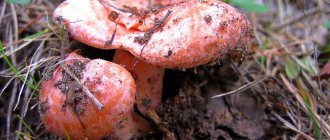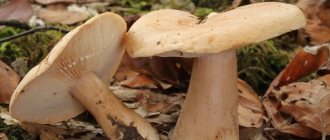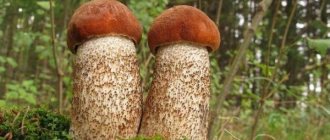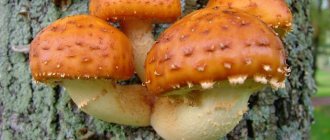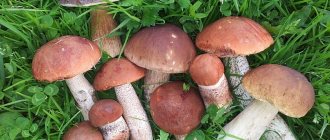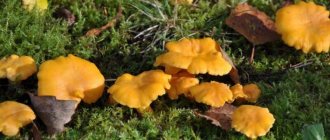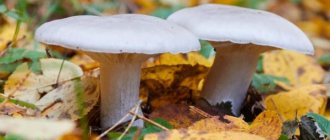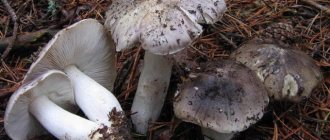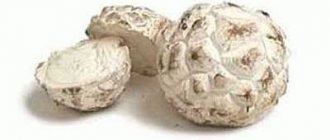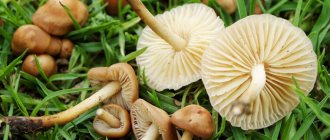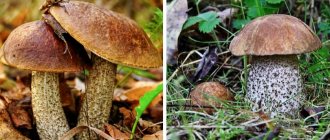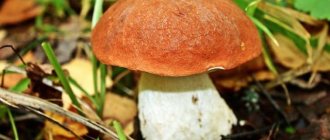The boletus mushroom is distinguished by the presence of a thick stalk, covered with scales similar to gray-brown fibers. It reaches a maximum height of 20 cm. The boletus pulp has a dense white structure. It tastes neutral, without the special smell that is found in many other mushrooms. This mushroom grows in deciduous and mixed forests.
There are especially many boletuses in young aspen groves. It is better to collect them in June until October and are usually found in large clusters. This mushroom can be called the most popular representative of the mushroom kingdom. Since they have a color similar to fallen leaves, they are not so easy to find. The article will tell you everything about the features of boletus, where to look for them, and also how to distinguish them from other species.
Boletus
Botanical description of the boletus mushroom (redhead)
It is no secret that redheads mean several types of Lenzium mushrooms , or as they are also called obabkov. This includes most representatives with a pronounced cap and stem. This type of structure is called capped.
The boletus can be distinguished by its characteristic tubular cap and thick body, permeated with soft fibrous pores, which is characteristic of the entire genus.
Boletuses grow in almost every forest in the temperate climate zone
Boletus Yellow – Brown Leccinum Versipelle
Boletus mushroom is a famous, beautiful and tasty
mushroom from the genus Obabok, the Boletaceae family. Also known as Obabok the Many-Skinned.
Appearance
The cap is up to 20 or even 30 cm in diameter, initially spherical, later convex or flattened in shape. The color of the cap varies from red to yellowish-gray.
The hymenophore is tubular, the tubes are finely porous, easily separated from the cap, colored in light gray shades, becoming lighter with age.
Spore powder is yellow-brown.
The leg is up to 20 cm high and up to 5 cm in diameter, cylindrical and solid, thickening downwards, painted white, with a slightly greenish tint at the base. Covered with black and gray fibrous scales.
The pulp is light, turns purple when broken, and has no pronounced taste or smell.
Where and when does it grow
Fruits from June to the end of October, in mixed and deciduous forests. Forms mycorrhiza with birch. Peak fruiting occurs at the beginning of September.
Culinary use
An excellent edible mushroom, suitable for any type of culinary processing.
Where do they grow and when to collect boletuses?
These mushrooms grow in almost every forest in the temperate climate zone. Contrary to current stereotypes, you can find one or a whole cluster of boletuses near coniferous and deciduous trees. The best place for their life is still a shady area covered with tall grass, near roads and trails.
The appearance of the obobok directly depends on the species and what plant it formed mycorrhiza with. The cap, small and clearly visible against the background of grass, can be not only yellow, but also gray, reddish, or light brown. As a rule, it is slightly rounded at the bottom and feels like velvet.
It is better to go collecting boletuses at the very beginning of summer, but it is recommended to end the mushroom season in mid-autumn. It is better to pay attention to shady places surrounded by low thickets of grass.
Time and place of growth
The first boletus mushrooms appear already in June. Therefore, in some places they are traditionally called “spikes” (since during this period the rye begins to spike). Undoubtedly, the first porcini mushrooms and boletus mushrooms can rightfully be included among them.
Most often, this mushroom is found under the name red-headed boletus.
It grows mainly in mixed forests, and the mycelium (mycorrhiza) is still mostly associated with aspen, so it is often found among them or nearby.
They can also often be found in young growth, in deciduous forests (especially birch) and in aspen thickets. In dry summers, boletus can grow in more mature aspen forests. It is found (including the red mushroom) even in coniferous forests (for example, pine forests). You can find it on forest edges and in abandoned fields, overgrown with trees and shrubs. Moreover, this mushroom usually grows in groups.
In the world, the mushroom is distributed throughout the Northern Hemisphere (temperate zone). Boletus grows a lot in North America and Central Europe, and they are less common in the mountains of Southern Europe.
Useful and medicinal properties of boletus
Redhead is often used as a main or additional dish in a diet due to its low calorie content.
It can be the main ingredient in a soup, stew or even a salad. However, it is recommended for everyone to consume this mushroom, not just those who are losing weight, because boletus proteins are absorbed much better and faster than some types of meat. We also recommend reading:
We collect and eat greenfinch mushrooms Varieties of row mushrooms: photos and descriptions Where to collect mushrooms: Krasnodar region is a great place for a quiet hunt Unique mushrooms of the Crimea
It is noteworthy that all types of redhead can be eaten without harming your own health (this rule does not bypass people suffering from diabetes).
Contraindications
Despite the large amount of useful substances in their composition, these mushrooms are more capable of accumulating toxins from the soil than other species. You should not use overgrown mushrooms, or collect them near highways, big cities and industrial enterprises.
The product is heavy, so in case of kidney and liver failure it can cause harm to the body. Also, this mushroom should not be eaten by children and people suffering from individual intolerance to the components of this type of mushroom. To avoid botulism, it is cut higher, leaving part of the stem in the ground.
Types of boletus mushroom
Variegated Redhead
Representatives of this species are usually found near a birch grove. Its fairly dense structure, long scaly leg and varying width of the mushroom cap are unlikely to allow it to be confused with the faceless toadstool. It’s better not to look for anything nearby - the multi-skinned redhead most often grows alone , attracting attention with its pale brown or orangeish skin color.
Pine obabok
This mushroom likes to hide in damp, well-saturated areas located near pine trees or swamps. The redhead reveals its presence only by the bright red or crimson color of its wide cap and long, gray-speckled leg (most often it does not exceed 15 cm in length).
Pine obabok
Spruce boletus
If you come across this species of redhead on your way, be sure to look around, because these mushrooms prefer to grow in small groups in the shade of coniferous trees. The firm flesh has a dark brown tint, but the skin, on the contrary, will delight you with a light brown tint.
White boletus
The huge (from 20 cm) white or brownish-beige cap of this mushroom peeks out in damp pine and spruce forests, less often in birch thickets. Like any other boletus, white boletus is edible and does not pose a threat to human health.
Not everyone can find such mushroom prey: this type of redhead is quite rare in central Russia.
Oak boletus
You will have to find it in the enchanting oak thickets. A small chestnut cap on a thick, rough stem will not be the only one, because mushrooms of this species do not grow alone . Their life span spans summer and early autumn.
Oak boletus
Red boletus
Clusters of pine and bearberry will certainly please beginners and experienced mushroom pickers with a harvest of red mushrooms. The bright cap, tightly fitting to the stem, is unlikely to be invisible near well-trodden forest paths or aspen stands. It rarely grows alone and is not poisonous to humans.
Painted redhead
Unfortunately, only residents of Asia can find such a mushroom. The boletus is famous for its fruit body covered with pinkish spots and its slightly curved cap. Despite everything, the mushroom is loved not only by people, but also by insects, so finding it untouched by the small inhabitants of the forest is a really difficult task.
Painted redhead
Blackscaled Butterfly
In front of you is a red hat slightly curved upward and a leg entwined with black scattering? Then don’t hesitate and hesitate to make your choice – feel free to add it to your cart and carefully look around.
The black-scaled mushroom can also be recognized by its hard fibers, which maintain a shape so attractive to the fungus.
Spruce redhead
If the boletus you find has a thin orange skin, then most likely you found it in a mixed or coniferous forest. This mushroom appears only in mid-July and grows until the beginning of October, puzzling mushroom pickers - this is one of the few boletuses whose cap has scales.
Spruce redhead
Description
The size of the aspen cap in diameter ranges from 4 to 30 centimeters. In young specimens it has a hemispherical shape. The edges of the caps tightly wrap around the legs. The tiny cap is pressed, like a thimble on a finger, onto a redhead mushroom that has just broken through the ground.
The photo clearly demonstrates the shape of the caps of young specimens and their fit to the stem. It is for this appearance that mushroom pickers love tiny boletuses. This appearance eloquently indicates that the mushrooms are healthy, have dense and elastic flesh, not affected by worms.
Mature redheads are crowned with cushion-shaped caps. These mushrooms, or rather their caps, with a smooth, slightly velvety surface, are painted in red or terracotta shades. Adjacent to their caps is a tubular layer that is white with olive or yellowish tints.
The height of the stocky cylindrical legs varies from 10 to 20 centimeters. The thickness of the legs can reach 5 centimeters. Inside they are solid, widening towards the base. Their color is white or grayish. The surface is densely covered with flake-like scales, brown or black. The scales darken as the fruiting bodies grow. All representatives belonging to the Obabkov family are endowed with similar legs. Boletus mushrooms, for example, have similar legs.
The redhead mushroom is endowed with white flesh. Its description is as follows: compacted, fleshy, elastic in the caps, first turning pink when cut, then turning black, exuding a faint pleasant odor. As the mushroom grows, it softens in the caps and becomes fibrous in the legs.
Aspen trees grow quickly. They are able to gain 20 grams per day. Accelerated growth leads to rapid decrepitude. The lifespan of boletuses is only 11 days.
What does a false boletus look like?
For some reason, among most mushroom pickers there is a legend about the so-called false boletus. But is it real, and what mushroom can redcap be confused with? We suggest that you look into this issue, avoiding accidental and dangerous finds.
It’s worth starting with the fact that there are no false assumptions. They are most often mistaken for a poisonous gall fungus, which has a lighter skin. You can distinguish it from boletus by other parameters:
- The cap of the gall mushroom has a larger diameter than the cap of the boletus.
- The tall and dense leg of a real boletus is decorated with small black scales, but the leg of a “false” boletus is decorated with large gray cracks and fibers.
Aspen Boletus Harrya Chromapes
Boletus mushroom is a famous, beautiful and tasty
mushroom from the genus Garria, the Boletaceae family. Also known as the Painted-legged Obabok and the Painted-legged Garria.
Appearance
The hat, up to 11 cm in diameter, is cushion-shaped, has a soft felt surface and a pink color, often uneven, spotted, with a lilac or olive tint.
The Hymenophore type is tubular, the tubes are wide, colored in pinkish-gray shades, greatly darkening over time. Spore powder is chestnut-brown.
The leg is up to 11 cm long and up to 2 cm thick, painted white or pink and covered with dark pink scales. It may be yellow at the base.
The flesh has a pink tint, and the base of the stem is yellow. It turns pink when cut, then darkens. Without pronounced taste and smell.
Where and when does it grow
It grows from July to September in oak and pine forests. In Russia it is found in the Far East and Eastern Siberia.
Culinary use
This species comes from a different genus than other boletuses, and therefore is somewhat inferior to them in taste. But this is also a good edible mushroom, classified in the second taste category.
Why is the boletus called that?
The name boletus is easily explained by the fact that this mushroom is most often found in young aspen trees. In addition to boletus, the mushroom has such names as obabok, vanka-vstanka and, of course, redhead. It owes such names only to mushroom pickers of long-gone years, its own structure and unusual color.
Finally, I would like to wish every beginner and even experienced mushroom picker to come across a whole clearing of such a wonderful harvest, which has truly unique taste properties. Do not forget that he can wait for you not only under young aspens, but also under other trees, hiding among sparse grass.
Post Views: 187
Application
In cooking
Boletuses can be fried, baked, boiled, or grilled. Try making fried boletus according to this recipe:
- Cut the peeled onion into small cubes and fry in a mixture of butter and vegetable oil (2 tablespoons each) for 5 minutes.
- Peel, wash 500 g of redheads, cut the legs higher and clean.
- Cut the mushrooms into slices and add to the onions.
- Fry for another 2-3 minutes, cover with a lid and simmer until the liquid evaporates.
- After this, fry the mushrooms for another 7-10 minutes, add 3 tbsp. l. sour cream, spices, salt and simmer over low heat for 5 minutes.
In folk medicine
Traditional healers use boletus, mushrooms (photos of different types are posted at the end of the article) and related species for the prevention and treatment of atherosclerosis, cancer, gastrointestinal diseases, and loss of strength. For medicinal purposes, raw mushrooms, dried mushroom powder, and alcohol tincture from the caps of young redheads are used. Before starting treatment, you should consult your doctor, and do not use these remedies to treat children, pregnant or lactating women.
